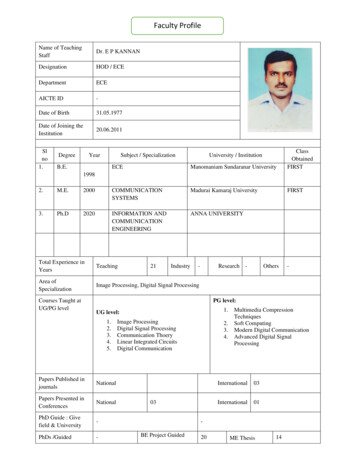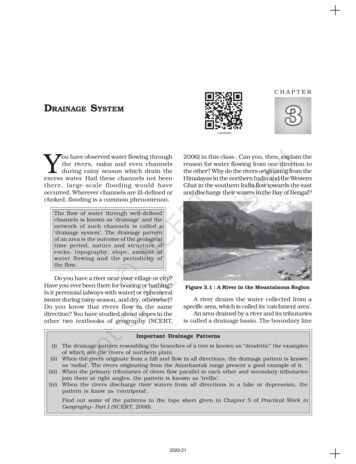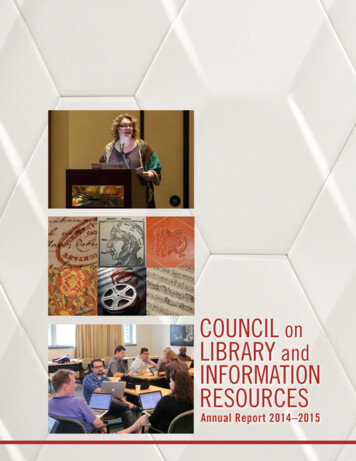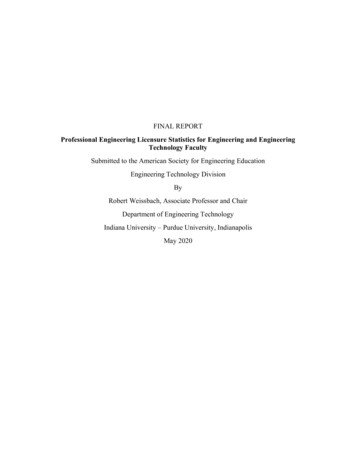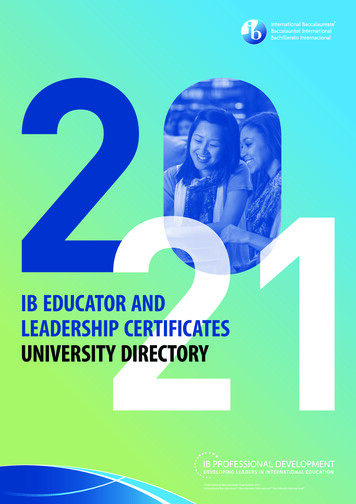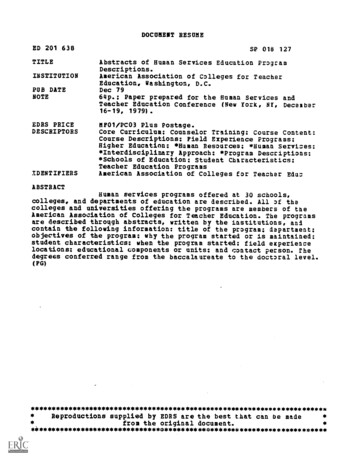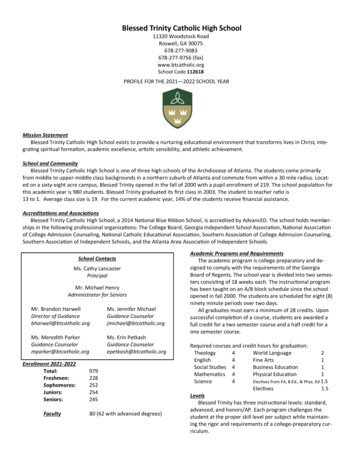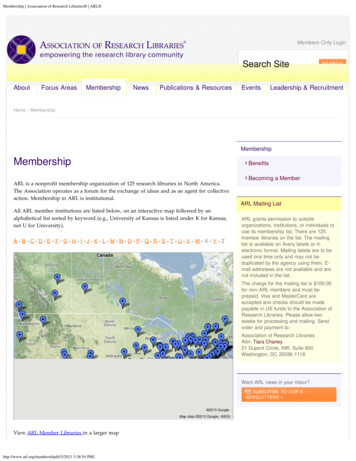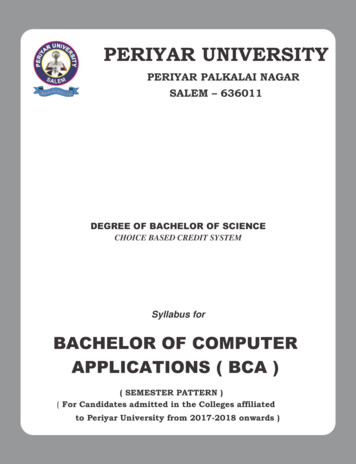
Transcription
PERIYAR UNIVERSITYPERIYAR PALKALAI NAGARSALEM – 636011DEGREE OF BACHELOR OF SCIENCECHOICE BASED CREDIT SYSTEMSyllabus forBACHELOR OF COMPUTERAPPLICATIONS ( BCA )( SEMESTER PATTERN )( For Candidates admitted in the Colleges affiliatedto Periyar University from 2017-2018 onwards )
(
PERIYAR UNIVERSITYREGULATIONS1.ELIGIBILITYRefer this office circular No: PU/R/AD-1/UG/PG/Programmes Eligibility/2019 Dated: 16-04-2019.2.DURATION OF THE COURSEThe course shall extend over a period of three years comprising of six semesters with two semestersin one academic year. There shall not be less than 90 working days for each semester. Examinationshall be conducted at the end of every semester for the respective subjects.3.COURSE OF STUDYThe course of study shall comprise instruction in the following subjects according to the syllabus andbooks prescribed from time to time. The syllabus for various subjects shall be clearly demarcated intofive units in each subject. Part -I, Part-II, Part – III, Part – IV and Part-V subjects are as prescribed inthe scheme of examination.4.EXAMINATIONSThe theory examination shall be three hour duration for each paper at the end of every semester. Thecandidate failing in any subject(s) will be permitted to appear in the subsequent examination. Thepractical examinations for core subjects should be conducted at the end of the every semester.4.(a) Submission of Record Note Books for Practical ExaminationsCandidates appearing for practical examinations should submit bonafide Record Note Booksprescribed for practical examinations, otherwise the candidates will not be permitted to appear for thepractical examinations. However, in genuine cases where the students who could not submit therecord note books, they may be permitted to appear for the practical examinations, provided theconcerned Head of the Department certified that the candidate has performed the experimentsprescribed for the course. For such candidates zero (0) marks will be awarded for record note books.5.REVISION OF REGULATIONS AND CURRICULUMThe University may revise/amend/ change the Regulations and Scheme of Examinations, if foundnecessary.03
BCA6.PASSING MINIMUMMARKS TheoryThe candidate shall be declared to have passed the examination if the candidate secure not less than40 marks put together out of 100 marks (CIA EA).Minimum 40% should be secured (30 out of75) in EA of each theory subject.PracticalThe candidate shall be declared to have passed the examination if the candidate secure not less than40 marks put together out of 100 marks (CIA EA). Minimum 40% should be secured (24 out of60) in EA of each Practical subject.7. MARKS DISTRIBUTION AND QUESTION PAPER PATTERN FOR BCA7.1 Theory –Marks DistributionMaximum Marks:100 MarksExternal [EA]:75 MarksInternal [CIA]:25 Marks7.1 (a). Theory - Question Paper Pattern [External](Total Marks: 75)PART – A (10 x 2 20 Marks)(Answer ALL questions), (Two questions from each unit)PART – B (5 x 5 25 Marks)(Answer ALL questions) & (One question from each unit with Internal Choice)PART – C (3 x 10 30 Marks)(Answer ANY THREE questions) &(Open Choice – 3 out of 5 questions)7.1 (b). Theory - Internal Marks Distribution04(Total Marks: 25)Attendance:5 MarkSAssignment:5 MarkSTest:15 Marks
PERIYAR UNIVERSITY7.2. Practical – Marks DistributionMaximum Marks: 100 MarkSExternal [EA]: 60 MarksInternal [CIA]: 40 Marks(Total Marks: 60)7.2 (a).Practical - External Marks DistributionFor each practical question the marks should be awarded as follows (External)i) Algorithm / Flowchart- 20%ii) Writing the program in the main answer book- 30%iii) Test and debug the program- 30%iv) Display the correct output- 20%(Marks may be proportionately reduced for the errors committed in each of the above)Practical Question Paper PatternStudent should attend two questions (either or pattern)Note:(i) Practical I to Practical VI and SBEC Practical has same pattern(ii) Core Practical Examination must be conducted at the end of every Semester7.2 (b). Practical - Internal Marks Distribution (Total Marks: 40)Record: 15 MarksInternal Practical examinations:25 Marks8. COMMENCEMENT OF THIS REGULATION:These regulations shall take effect from the academic year 2017-2018, i.e, for studentswho are to be admitted to the first year of the course during the academic year 2017-18 andthereafter.05
BCASCHEME OF EXAMINATIONS FROM THE ACADEMIC YEAR2017-2018 CREDITS DISTRIBUTION AS PER THE UNIVERSITYNORMS.SEMESTERIIIIIIIVVVIPART - I3333--12PART - --2VALUE EDUCATION2-----2EXTENSION ACTIVITY-----11Cumulative Total Credits22242324252714506Total Credits
PERIYAR UNIVERSITYCOURSE OF STUDY AND SCHEME OF EXAMINATIONCreditsSubject STER IITamil I6-32575100IIEnglish I6-32575100IICore IComputer Applications for Automation5-52575100IIIPractical - IOffice Automation-444060100IIIIVAllied 5435600SEMESTER IIITamil II6-32575100IIEnglish II6-32575100IIICore IIC Programming4-42575100IIIPractical IIProgramming in C-344060100IIIAllied II4-32575100IIIAllied III4-32575100IVSBEC - 85800Internet and its ApplicationsTotal07
BCACreditsSubject STER IIIIIIIIIIIIIIIIIIIIIVCore IIICore IVCore VPractical IIIAllied IAllied IIPracticalNMEC –IFundamentals of Digital ComputersStructured System analysis and DesignData Structures and AlgorithmsData Structures using amil/ Advanced Tamil (OR)Non –Major elective – I2-22575100Total22822 0Practical Lab - I (*)SEMESTER IVIIIIIIIIIIVIVIVCore VICore VIICore VIIIPractical IVAllied IIPaper - IIAllied IIPracticalRelational Database Management SystemsOperating SystemsObject oriented Programming with C Programming in C Practical Lab – I (*)-324060100SBEC - II :HTML and Java Script1122575100Tamil/ Advanced Tamil (OR)2-22575100570800IVNMEC - IINon –Major elective – ITotal228444426 230* Allied Practical Examination will be conducted at the end of even semester.08
PERIYAR UNIVERSITYCreditsSubject STER VIIICore IXWeb Technologies5-42575100IIICore XProblem solving techniques5-42575100IIICore XIJAVA Programming5-42575100IIIElective – I5-52575100IIIPractical VProgramming in Java-544060100IVSBEC - IIIPractical - Image Editing Tool-324060100IVSBEC - IVMulti skill Development2-22575100Total22851070025 190SEMESTER VIIIICore XIIGUI Programming5-42575100IIICore XIIIComputer Networks5-42575100IIIElective – II5-52575100IIIElective – III5-52575100IIIPractical VIProgramming in VB-544060100IVSBEC - VPractical-Android Programming-324060100IVSBEC - VIShell Programming2-22575100Extension Activity--1---228510700VTotal27 19009
BCAELECTIVE SUBJECTSElective – ISemVPartIIISubject CodeSubjectPaper IE-Commerce TechnologiesPaper IISystem SoftwarePaper IIIComputer GraphicsElective – IISemVIPartIIISubject CodeSubjectPaper ISoftware TestingPaper IIParallel ProcessingPaper IIIMultimediaElective – IIISemVI10PartIIISubject CodeSubjectPaper IData mining and WarehousingPaper IIImage ProcessingPaper IIIMobile Computing
PERIYAR UNIVERSITYSubjectCodeLabSubject TitleIVMarksCreditsHoursLect.SemesterPartSBEC – Skill Based Elective Courses*CIAEATotalIISBEC – I : Internet and its Applications1122575100IVSBEC – II : HTML and JAVA Script1122575100VSBEC – III : Practical-Image Editing Tool-324060100VSBEC - IV : Multi Skill Development3-22575100VISBEC - V : Practical-Android Programming-324060100VISBEC-VI : Shell Programming2-22575100Non Major Elective Course – (NMEC)Extra Disciplinary Subjects offered by the Department of Computer Science The department canSubject CodeMarksSubject TitleLect.HoursCreditsSemesterPartoffer any one of the subjects to the other major subject students in each semester.CIA EATotalIIINMEC I: Basics of Computers222575100IIINMEC I:System Administration and222575100MaintenanceIVIVNMEC II: Office Automation222575100IVNMEC II: Basics of Internet22257510011
BCAAllied Subjects for any Degree offered by the Department ofComputer ScienceSYLLABUS - CBCS PATTERNEFFECTIVE FROM THE ACADEMIC YEAR 2017-2018All Papers should be handled and valued by Computer Science Department only. ForUniversity practical examinations both Internal and External examiners should be appointedfrom Computer Science Department.FIRST OPTION (Allied Computer Science)HoursAllied – I C Programming4-22575100I/IIAllied Practical – I Programming in C-324060100II/IVAllied – II C Programming4-32575100II/IVAllied Practical–II Programming in C -324060100Lect.I/ IIPartCreditsSubject TitleMarksLabSemesterSubject CodeFirst Year / Second Year (Select any one of the Subject with Practical)CIA EATotalIIISECOND OPTION (Allied Computer Science)MarksLaCrbeditsHoursLect.Subject CodePartSemesterFirst Year / Second Year (Select any one of the Subject with Practical)Subject TitleCIAEATotalI/ IIIAllied – I Database Systems4-32575100I/IIAllied Practical – I MS-Access-324060100II/IVAllied II E–Commerce Techniques4-32575100II/IVAllied Practical – II HTML Programming-324060100III12
PERIYAR UNIVERSITYTHIRD OPTION (Allied Computer Science)III II/IVII/IVSubject TitleMarksin Office4-32575100Allied Practical – I Office Automation-324060100Allied – II Image Editing Tool4-32575100Allied Practical–II Image Editing Software-324060100Lect.CreditsI/IIHoursLabI/ IIISubject CodePartSemesterFirst Year / Second Year (Select any one of the Subject with Practical)CIA EATotalAllied – I Computer ApplicationsFOURTH OPTION (Allied Computer erPartFirst Year / Second Year (Select any one of the Subject with Practical)Subject TitleCIAEATotalI/ IIIAllied – I PHP Scripting Language4-32575100I/IIAllied Practical – IPHP Programming-324060100II/IVAllied – II Basics of Computer and4-32575100-324060100Financial ComputingIIIII/IVAllied Practical – II FinancialComputing Software13
BCAAllied Papers for B.Sc. Computer Science offered by other DepartmentsI - YEAR (Allied – I: First Option)MarksPartSubject TitleIAllied I : Paper–I: Algebra and Fourier seriesIIAllied I : Paper–II: Differential ursCIAEATotal25751006-4and Laplace Transforms4-32575100Allied I : – III : Practical-434060100I - YEAR (Allied – I: Second Option)MarksPartIIILabCreditsSubject d I : Paper – I: Discrete Mathematics6-42575100IIAllied I : Paper – II: Numerical Methods4-32575100Allied I : Paper – III : Graph Theory4-32575100III-Year (Allied – I: Statistics –Third Option)MarksPartIIICreditsLabSubject d I :Paper–I: Allied Statistics –I6-42575100IIAllied I :Paper–I: Allied Statistics –II4-32575100Allied I :Paper–I: Allied Statistics –III4-32575100II(Practical)14
PERIYAR UNIVERSITYSubjectCodeLabSubject TitleMarksCreditsHoursLect.SemesterPartII - YEAR (Allied – II: COMMERCE -First Option)CIA EAIIIAllied II : Paper – I: Principles of AccountingIVAllied II : Paper – II: Cost and ManagementIII/IVIIITotal6-42575100Accountingllied II : Practical Lab -1: Allied bSubject TitleMarksCreditsHoursLect.SemesterPartII - YEAR (Allied – II: ELECTRONICS - Second Option)CIA EAAllied II: Paper – I: Applied Electronics-IIIIIVIIIIII/IVAllied II:Paper – II: Applied Electronics-IIAllied II: Practical Lab -1: AlliedElectronics Lab arksLabCreditsHoursLect.SemesterPartII - YEAR (Allied – II: PHYSICS - Third Option)Subject TitleCIA EAIIIIII IVIII/IVTotalAllied II : Paper – I: Allied Physics – I6-42575100Allied II : Paper – II: Allied physics – II4-32575100-224060100Allied II : Practical Lab -1Allied PhysicsPractical15
B.CASc. HOME SCIENCEBACHELOR OF COMPUTER APPLICATION (B.C.A.)SEMESTER ICORE I - COMPUTER APPLICATIONS FOR AUTOMATIONUNIT – IIntroduction to Computers: Introduction- Importance- History- AnatomyUNIT IIMS-Word: Basics –Do's and Don'ts – Menus – Commands – Tool Bars – Icons – Word FormattingTool BarUNIT – IIIMS-Excel: Basics – Do's and Don'ts – Menus – Commands – Tool Bars – IconsUNIT – IVMS-PowerPoint: Basics – Menus – Tool Bars – NavigationUNIT –VMS-Access: Introduction – Parts of an Window: - Creating a New Data Base – Table Wizard –Renaming – Saving the Database –Relationships – Query – Form – Reports – Exiting MS-AccessTEXT BOOK1. Sanjay Saxena, ―MS-Office 2000 for everyone‖, Vikas Publishing House Pvt. Ltd, Reprint 2006REFERENCE BOOKS1. Nellai Kannan, ―MS-Office‖, Nels Publications, 3rd Edition, 2004.2. John Walkenbach, Herb Tyson, Michael R.Groh, Faithe Wempen and Lisa A.Bucki , ―Microsoft Office 2010 Bible ―, Wiley India Pvt. Ltd , Reprint 20100416
PERIYAR UNIVERSITYBACHELOR OF COMPUTER APPLICATION (B.C.A.)SEMESTER ICORE PRACTICAL I - OFFICE AUTOMATIONWORD PROCESSOR1.i) Create a document, save it and edit the document as follows:ii)a.Cut, Copy, Paste options.b.Find and Replace options.c.Undo and Redo options.Format the document:a.Using Bold, Underline and Italic.b.Change Character style and size.c.Formatting paragraph: Center, Left aligns & Right alignd.Changing paragraph and line spacing, Using Bullets and Numbering in Paragraphs.e.Creating Hanging Paragraphs2.Enhance the documents using Header, Footer, Page Setup, Border, Page number, watermarking,Orientation and Print Preview.3.Insert tables and pictures in a document as follows4.a.Creating Tables in a document, Selecting Rows & Column sort the recordb.Insert a picture – edit size and add name of the picture above it.c.Also do basic text formatting like – bold, italic, underline, alignments etc in table.,Using mail merge, send an invitation /notice (by creating the invitation/notice) for the followingsituation (at least 5 addresses to be entered) (Any one of the following)a.For opening a new branchb.Inauguration functionc.Informing about new scheme or offer17
BCASPREADSHEET5.a. Create a worksheet, moving/ copying/ inserting/ deleting rows and columns (usage of cut, paste,commands, copying a single cell, copying a range of data, filling up a cell. Undo command, insertinga row, column, deleting rows and columns).b. Formatting worksheetsBold, Italic, Font size changing, Auto fill, date format, Currency format6.Open an excel and create fields as followsName of theS.NoM1M2M3studenti. Enter S.No, Name, marks for 10 studentsii.M4M5TotalAvgResultGradeFind total and average using formula.iii. Find Result whether the student is pass or fail and also assign grade as per our university norms.iv. Insert a column chart showing the comparison of marks in different subjects of differentstudents.7.i) Creating and running a macro.ii) Assigning button to a defined macro.iii) Editing a macro.PRESENTATION8.Create a presentation with apply background/Themes, apply custom animation on text, insertimages/word art and animate the images with effects.9.Create ―My album‖ use photos, audio, and videos with necessary Transition Effects10. Making an Organization Structure in Power PointStarting an organization chart, Entering names and Titles, Adding Members, Formatting the Boxes,Text and Lines, Rearranging the Org Chart, Finishing the Chart18
PERIYAR UNIVERSITYBACHELOR OF COMPUTER APPLICATION (B.C.A.)SEMESTER IICORE II - C PROGRAMMINGUNIT– IOverview of C: History of C – Importance of C – Basic structure of C programs. Constants, variablesand data types: Character set – C Tokens – Keywords and identifiers – Constants – Variables –Declaration of storage classes – Assigning values to variables- Defining symbolic constants.Operators and expression – Evaluation of expressions – Precedence of arithmetic operators – Typeconversions in expressions – Operator precedence and associatively – Mathematical functions.Managing input and output operations: Reading and writing a character – Formatted input and output.UNIT– IIDecision making and branching: Simple IF, IF-ELSE, Nesting of IF-ELSE, ELSE-IF ladder, Switchstatements – GOTO statements. Decision making and looping: WHILE statement – DO statement –FOR statement – Jumps in loops. Arrays: Definition & Declaration – One dimensional – Twodimensional – Multi dimensional arrays - Dynamic arrays.UNIT – IIICharacter arrays and strings: Introduction – Declaring and initializing string variables – Readingstrings from terminal – Writing strings to screen – String handling functions – Table of strings. User– Defined functions: Introduction – Need for user – Defined function – A Multi- function program –Elements of user – Defined function – Definition of functions – Return values and their types –Function calls – Function declaration – All category of functions – Nesting of functions – Recursion– Passing arrays to functions – Passing strings to function.UNIT – IVStructures and Unions: Introduction – Defining a structure – Declaring structure variables –Accessing structure members – Structure initialization – Copying and comparing structure variables– Arrays of structures – Arrays within structures – Structures within structures – Structures andfunctions – Unions – Size of structures – Bit fields.Pointers: Introduction – Understanding pointers – Accessing the address of a variable – Initializing ofpointer variables. Chain of pointers – Pointer expressions –Pointers and arrays – Pointers andcharacter strings – Arrays of pointers – Pointers as function arguments – Functions returning pointers– Pointers to functions – Pointer and structures.19
BCAUNIT – VFile Management: Introduction – Defining and opening a file –Closing a file – Input/Output operation onfiles – Error handling during I/O operations – Random access files – Command line arguments.TEXT BOOK1.E. Balgurusamy, ―Programming in ANSI C‖, 5th Edition, Tata McGraw Hill, New Delhi, 2010.REFERENCE BOOKS1. Herbert Schildt, “C: The complete Reference‖, 4th Edition, McGraw Hill, 2003.2.B.L.Juneja, ―Programming in C‖, 1st Edition, Cengage Learning, 2012.20
PERIYAR UNIVERSITYBACHELOR OF COMPUTER APPLICATION (B.C.A.)SEMESTER IICORE PRACTICAL II - PROGRAMMING IN C1. Write a simple C program to find the total and average percentage obtained by a student for 6 subjects.2.Write a simple C program to check whether a given character is vowels or not using Switch – CaseStatement3.Write a simple C program to print the numbers 1 to 10 along with their squares4.Write a simple C program to find the sum of 'n' numbers using for do-while statement5.Write a simple C program to find the factorial of a given numbers using Function6.Write a simple C program to swap two numbers using call by values and call by reference7.Write a simple C program to find the smallest and largest element in an array8.Write a simple C program to perform matrix multiplication9.Write a simple C program to find the sum of an integer array using pointers10. Write a C program to copy the contents of one file into another21
BCABACHELOR OF COMPUTER APPLICATION (B.C.A.)SEMESTER IIICORE III - FUNDAMENTALS OF DIGITAL COMPUTERSUNIT – IDigital Principles: Definition for digital signals – Digital waveforms – Digital logic – Moving andStoring Digital Information – Digital Operations – Digital computers – Digital Integrated Circuits.Digital Logic: The Basic Gates - NOT, OR, AND –Universal Logic Gates – NOR, NAND – ANDOR-Invert Gates – Positive and Negative Logic.UNIT – IICombinational Logic Circuits: Boolean Laws And Theorems – Sum-of-products Method – TruthTable to Karnaugh Map – Pairs, Quads, and Octets – Karnaugh Simplification – Don't-careConditions – Product-of-sums Simplification. Data–Processing Circuits: 16-to-1 Multiplexer – 1-to16 De-multiplexer – BCD-to-decimal Decoder – Decimal-to-BCD Encoder – Exclusive-or Gates –Parity Generation and Application.UNIT - IIINumber Systems and Codes: Binary Number System – Binary-to-decimal Conversion – Decimal-tobinary Conversion – Octal Numbers – Hexadecimal Numbers – The ASCII Code – The Excess-3 Code –The Gray Code. Arithmetic Circuits: Binary Addition –Binary Subtraction –Unsigned Binary Numbers –Sign-magnitude Numbers - 2'S Complement Representation - 2'S Compliment Arithmetic.UNIT - IVArithmetic Circuits: Arithmetic Building Blocks – The Adder - subtractor – Fast Adder – ArithmeticLogic Unit – Binary Multiplication and Division. Clocks and Timing Circuits: Clock Waveforms. FlipFlops: RS Flip-flops – Edge-triggered D Flip-flops - Edge triggered JK Flip-flops – JK Master-slaveFlip-flops.UNIT - VRegisters: Serial-In Serial-Out – Serial-In Parallel-Out – Parallel-In Serial-Out – Parallel-In ParallelOut (54/74174). Memory: Introduction - Magnetic Memory - Optical Memory - Memory Addressing- ROMs, PROMs, EPROMs and EEPROM – RAMs-7489. A Simple Computer Design.TEXT BOOK1. Donald P Leach, Albert Paul Malvino and Goutam Saha, ―Digital Principles and Applications,‖ 8thEdition, TMH, 2006.REFERENCES1. Morris Mano, "Digital Logic and Computer Design," 4th Edition, Pearson, 20082. Thomas C Bartee, "Digital Computer Fundamentals," sixth edition, McGraw-Hill, 19853. Pradeep K. Sinha, Priti Sinha , "Computer Fundamentals," Sixth Edition, BPB Publications, 200722
PERIYAR UNIVERSITYBACHELOR OF COMPUTER APPLICATION (B.C.A.)SEMESTER IVCORE IV - STRUCTURED SYSTEM ANALYSIS AND DESIGNUNIT-ISystem Concepts & Information System Environment: System concepts – definition, characteristicsof a system, Elements of a system, Types of a System, introduction to system Analysis and Design –system Analysis, System Design, System Development Life Cycle.UNIT-IIThe Information System Analysis: Introduction – where does the system analysis come from? – Whatdoes it do? – Preparing for Career as a Analyst – general Business Knowledge – Technical Skills –Communication skills – Role of System Analyst – Change Agent – Investigator – and Minor –Psychologist, Sales Person, Motivator, Politician, Place of the System analyst position in the MISorganization.UNIT-IIISystem Analysis: Problem who System Development Life Cycle approach, Neet for a Structuredapproach, Information Gathering. A problem solving approach – Data Flow Diagrams, Datamodeling with logical entity relationship. Process modeling with logical data diagram, Datadictionary, Decision tree, Decision tables and Structured English.UNIT-IVSystem Design : Introduction , The Process of Logical & Physical design – Modern Computer Databases– Different kinds of databases – E.R.models – E-R diagrams – Normalization. Computer outputs andcontrols, computer inputs and controls, Code design , Computer based methods. Procedures andcontrols.UNIT-VSystem Implementation : System testing Conversion Compating resistance to change PostImplementation review Software maintenance Hardware/ Software Selection Security disaster/recovery and ethics in System development . Case Analysis.TEXT BOOK1. Elias M.Awad, ―System Analysis and Design‖, 2nd Revised edition, 1985.REFERENCE BOOKS1. Jerry L.Whitten . Lonnie D.Bently & Victor M.Bar ―System Analysis and Design‖,20072. Robert J Thierauf, ―System Analysis and Design – A Case study approach‖, 19863. Henry F.Korth , Abraham Silberchatz & Sudharsan, ―Data base System Concepts‖, SixthEdition, 2010.23
BCABACHELOR OF COMPUTER APPLICATION (B.C.A.)SEMESTER IIICORE V - DATA STRUCTURES AND ALGORITHMSUNIT -IAlgorithms: Problem solving – Top-Down and Bottom- up approaches to algorithm design – Use ofalgorithms in problem solving – Design, Implementation, Verification of algorithm – Efficiency analysisof algorithms: Space, Time complexity, and Frequency count – Sample algorithms: Exchange the value oftwo variables – Summation of set of numbers – Decimal to Binary conversion – Sorting – Factorial –Fibonacci – Finding a largest Number in an array - Reverse the order of elements in array.UNIT- IIData structure: Introduction - Definitions – concepts – Overview – Implementation of DataStructures. Arrays: Definition – Terminology - One dimensional array – Multi Dimensional Array.Stacks: Introduction – Definition – Representation of stacks – Operations on stacks – Applications ofstack: Evaluation of Arithmetic Expression- Implementation of Recursion- Factorial CalculationUNIT -IIIQueues: Introduction – Definition – Representation of Queues –Various Queue structures: CircularQueue – De-queue – Priority Queue – Applications of Queues. Linked List: Definition -SingleLinked List - Double Linked List - Circular Double Linked List – Applications.UNIT- IVTrees: Terminologies – Definitions &Concepts – Representation of Binary tree – Operations on BinaryTree – Types of Binary Trees: Expression Tree – Binary Search Tree – Heap Tree – Red Black Tree.Graphs: Introduction – Graph terminologies – Representation of Graphs – Operations on Graphs –Application of Graph: Shortest path problem – Topological sorting – Minimum Spanning Trees.UNIT- VSearching: Terminologies – Linear Search techniques with – Array, Linked List, Ordered List, Binarysearch. Non Linear Search: Binary Tree Searching – Binary Search Tree Searching. Sorting:Terminologies – Sorting Techniques – Insertion Sort - Selection sort – Bubble sort – Quick sort –Merge sort –Heap sort.TEXT BOOKS1. Sathish Jain, Shashi Singh, ―Data Structure Made Simple‖, First Edition, BPB Publications, NewDelhi, 2006. (Unit - 1)2. Debasis Samanta, ―Classic Data Structures‖, second Edition, PHI Learning, New Delhi, July2009.(Unit 2-5)REFERENCE BOOKS1. ApritaGopal, ―Magnifying Data Structures‖, First Edition, PHI Learning, New Delhi, 2010.2. Horowitz, Sahni, Anderson-Freed,‖Data Structures in C‖, Universities Press, 2007.24
PERIYAR UNIVERSITYBACHELOR OF COMPUTER APPLICATION (B.C.A.)SEMESTER IIICORE PRACTICAL III - DATA STRUCTURES USING C1.Implement Push and Pop Operations of a Stack using Array2.Write a program to perform factorial calculation using recursion.3.Implement Add and Delete Operations on Queue using Pointer4.Implement Add and Delete Operations on Circular Queue5.Write a Program to convert an Infix Expression to Postfix Expression using Arrays.6.Write a Program to add Two Polynomials using Pointers.7.Perform Tree Traversals for a Binary Tree using Recursion.8.Write a program to perform Binary Search.9.Sort the given list of numbers using Heap Sort.10. Sort the given list of numbers using Quick Sort25
BCABACHELOR OF COMPUTER APPLICATION (B.C.A.)SEMESTER IVCORE VI - RELATIONAL DATABASE MANAGEMENT SYSTEMSUNIT – IIntroduction: Database System Applications–DBMS Vs. File System - View of Data–Data ModelDatabase Languages – Database users and Administrators - Transaction Management – DatabaseSystem Structure – Application Architecture. Data Models: Basic Concepts – Constraint- Keys- ERDiagram – Weak Entity – Extended ER Features - Design of an ER Schema – UML; RelationalModel: Structure of Relational Databases – Relational Algebra – Views.UNIT – IISQL: Background–Basic Structure–Set Operation–Aggregate Function–Null Values–Nested SubQueries – Views – Modification of the Database – Data Definition Language – Embedded SQL –Dynamic SQL.UNIT-IIIAdvance SQL : Integrity and Security: Domain – Constraint – Referential Integrity – assertions –Triggers – Security and Authorization – Authorization in SQL – Encryption and Authentication.UNIT – IVRelational Database Design: First Normal Form - Pitfalls in Relational Database Design–FunctionalDependencies (Second Normal Form) – Boyce-Codd Normal Form - Third Normal Form – FourthNormal Form – Overall Database Design Process.UNIT-VTransaction Management: Transaction concepts - States – Serializability. Lock based concurrencycontrol : Locks – Granting – Two-Phase Locking protocol. Time stamp based protocol: Timestamps– Timestamp ordering protocol – Dead lock handling.TEXT BOOK1.A Silberschatz, H Korth, S Sudarshan, ―Database System and Concepts‖, 5th Edition McGraw-Hill, 2005.REFERENCE BOOKS1.Alexis Leon & Mathews Leon, ―Essential of DBMS‖, 2nd reprint, Vijay Nicole Publications, 2009.2.Alexis Leon & Mathews Leon, ―Fundamentals of DBMS‖, 2nd Edition, Vijay Nicole Publications, 2014.26
PERIYAR UNIVERSITYBACHELOR OF COMPUTER APPLICATION (B.C.A.)SEMESTER ICORE VII - OPERATING SYSTEMUNIT – IIntroduction – History of operating system- Different kinds of operating system – Operation systemconcepts - System calls-Operating system structure.UNIT – IIProcesses and Threads: Processes – threads – thread model and usage – inter process communication.UNIT – IIIScheduling - Memory Management: Memory Abstraction – Virtual Memory - page replacementalgorithms.UNIT – IVDeadlocks: Resources- introduction to deadlocks – deadlock detection and recovery – deadlocksavoidance – deadlock prevention. Multiple processor system: multiprocessors – multi computers.UNIT – VInput/Output: principles of I/O hardware - principles of I/O software. Files systems: Files –directories - files systems implementation – File System Management and Optimization.TEXT BOOK1.Andrew S. Tanenbaum, ―Modern Operating Systems‖, 2ndEdition, PHI private Limited, New Delhi,2008.REFERENCE BOOKS1.William Stallings, ―Operating Systems – Internals & Design Principles‖, 5th Edition, Prentice – Hallof India private Ltd, New Delhi, 2004.2.Sridhar Vaidyanathan, ―Operating System‖, 1st Edition,Vijay Nicole Publications, 2014.27
BCABACHELOR OF COMPUTER APPLICATION (B.C.A.)SEMESTER IVCORE VIII - OBJECT ORIENTED PROGRAMMING WITH C 'UNIT – IObject-Oriented Programming: Principles – Benefits of OOP – Application of OOP – Tokens,Expression and Control Structures: Tokens – Keywords – Identifiers and Constants – Data types –Constants – Variables – Operators – Manipulators – Expressions – Control Structure.UNIT – IIFunctions – Prototyping – Call by Reference – Return by Reference – Inline Functions – DefaultArguments – const Arguments – Function O
periyar university periyar palkalai nagar salem - 636011 degree of bachelor of science choice based credit system syllabus for bachelor of computer applications ( bca )
